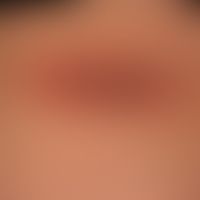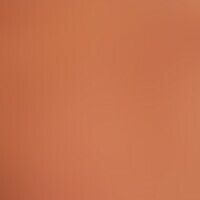Image diagnoses for "Torso"
563 results with 2198 images
Results forTorso

Acne comedonica L70.01
Acne comedonica. numerous comedones on the right shoulder blade of a 17-year-old patient. 3 years ago recurrent papules and pustules in the face as well as comedones in the area shown.

Mycosis fungoides C84.0
Mycosis fungoides: Plaque stage. 53-year-old man with multiple, disseminated, 1.0-5.0 cm large, in places also large, moderately itchy, clearly consistency increased, red rough plaques. development over 4 years.

Erythema migrans A69.2
Erythema chronicum migrans: Oval, slowly growing, completely symptom-free, red-brown, homogeneously filled stain, slightly darkened in the centre. persists for about 2 months. healing under 2-week therapy with doxycyline (200 mg). stain was still visible 6 months after completion of antibiotic therapy.

Erythrokeratodermia figurata variabilis Q82.8
Erythrokeratodermia figurata variabilis. very irregularly distributed, bizarrely configured, polycyclic, scaly plaques with alternating clinical expressivity and acuteness as well as very characteristic peripheral scaly ruffs (buttocks) in a 6-year-old boy. few symptomatic skin lesions existing since 2 years.

Becker's nevus D22.5
Becker nevus:Detail enlargement: nevus on the left upper arm/shoulder in a 14-year-old adolescent.

Nevus melanocytic halo-nevus D22.L
Nevus, melanocytic, halo-nevus. numerous depigmented, roundish, sharply defined, smooth, white spots with centrally located brown, slightly raised papules. 25-year-old patient with multiple halo- or sutton nevi occurring within a few months.

Pemphigus chronicus benignus familiaris Q82.8
Pemphigus chronicus benignus familiaris. marginal area: multiple crusty, sharply defined, red, rough plaques.

Contagious mollusc B08.1
Molluscum contagiosum: General view: Strongly itchy suberythrodermia with infestation of the entire anterior trunk, the back and the arms and legs of a 65-year-old woman with psoriasis vulgaris persisting since childhood; submammary and in the xiphoid region reddish, shiny, partly glassy appearing papules of 0.5-0.7 cm size.

Nummular dermatitis L30.0
Nummular dermatitis: Extensive eczema that has been present for several months, with blurred papules and confluent plaques; distinct itching.

Striae cutis distensae L90.6
Striae cutis distensae. in a growth spurt, "suddenly" occurred striae in a 13-year-old girl.

Basal cell carcinoma pigmented C44.L

Keratosis seborrhoeic (overview) L82
keratosis seborrhoeic: multiple flat wart-like skin growths that have persisted for years. arrows mark smaller, flat, light brown seborrhoeic keratoses. encircled: verucosal plaques or nodules that have existed for a long time (several years). patient complains of itching at times.

Syphilide papular A51.3
Syphilide, papular: multiple, disseminated, dense, small, reddish papules and nodules on a tanned integument in a 67-year-old patient; distinctly palpable, non-painful axillary and inguinal lymph nodes.

Carbuncle L02.94
Carbuncle: highly painful, inflammatory, bulging, fluctuating, centrally ulcerated red lump.

Anetoderma L90.1
Anetodermia (detailed view of multiple foci). slightly conspicuous, skin-coloured, symptomless, flat skin depressions with atrophic, finely wrinkled skin surface. scar-like aspect.









